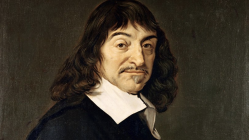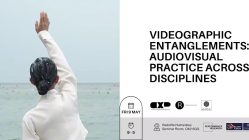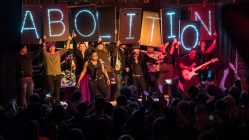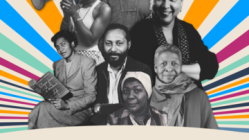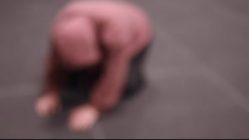Duration: 03:04
Project: Judaica
Practitioners: Ilona Krawczyk, Ben Spatz
Director: Nazlıhan Eda Erçin
Videography: Agnieszka Mendel
Date: 31 July 2017
Venue: University of Huddersfield
Source File: J132
COMMENTARY (April 2019)
Ilona
At the start of the session, Eda invited me to begin from whatever I wanted to explore. My impulse was to work with non-verbal sounds, integrating affect with physical action and taking inspiration from the “vocal dance” of pre-verbal communication described by Steve Mithen (2006). The following phenomenological description describes my experience during one of the improvised sequences that took place during this session.
I stand by the wall, improvising vocally a melody in a quality of voice which in my perception of that moment represents a connection to Jewish culture and the voice of the human. I see Ben approaching me and realize that I am standing between two columns. This realization, together with what I hear in my voice, leads me to visualize some kind of temple in which I am a sort of mediator between the worlds — earth and spirit — who calls upon heaven / god / demiurge, or perhaps is this persona from the spiritual world. When Ben kneels down in front of me, holding a book and chanting a song, I direct my eyes and my hands towards the ceiling while moving my voice towards higher notes in the head resonator. Through this I try to connect with humanity’s spiritual nature and, in a sense, get out of my body. But the closeness of Ben disturbs me. I growl at him. I want him to stop because I sense that he is bringing to the surface my other, animalistic, bodily nature. I try to come back to my intention, increasing its force even more. I step towards him, lifting my arms and eyes towards the ceiling in some kind of performance of a prayer. But when I hear Ben’s calling, when he starts to chant the text of the book, it gives me an impulse to go back to my body.
With my hands I touch my eyes, mouth, ears, breasts, belly, pubic mound, thighs, and ankles in repeated sequence. As I go down towards the floor, I release sounds of growling. I am torn between this new physical action or movement and the previous chanting. I still want to turn towards the ceiling, but the floor is calling me. I am torn between these two directions with my movement and voice. More and more animalistic sounds come out from me. I am trying to suppress them, to keep myself still in human verticality. I close my eyes and try to hold my body in this vertical position as much as possible. I put my feet close together and keep vocalizing, shifting between the melody and sounds of shouting and growling. While doing this, with my eyes constantly closed, I build up more and more tension in my muscles, particularly in the pelvic area. Somehow, I sense that this is the place of division and tear between the two worlds, animal and human. I place my hands on my belly and press to increase the tension even more. This tension and action affect my voice. I find an expression which is somehow in between, on the edge of the two registers and two expressions that I was using before. It is a prolonged howling. The growling and the melody are still appearing, but this third quality starts to speak through more. I begin to hear more and more the words chanted by Ben. When I reach the point of exhaustion caused by my actions, I open my eyes, looking up silently, still keeping my hands on my belly.
I listen to Ben chanting the text of the book. I am exhausted, feeling surrendered to some power that made me go through all of this. I realize the pain of being kept in this vertical world that does not allow me to howl: the pain of division, suppression, and the cost of being vertical. I feel anger towards religion. Something that was supposed to offer salvation became an oppression — this is the image of hands suppressing my belly. As the messiah was supposed to be the one who saves us from our earthy, animalistic, sinful nature, I slowly look down at Ben and say with reproach: “mess, messiah.”
I wrote the above phenomenological description after many months, when I was revising video material to work with Ben on a forthcoming book chapter. I was aware that something important happened for me during this sequence on the level of personal and artistic experience, but I only realised the full meaning when I was watching this material over and over again and writing a commentary on how it shows the manifestation of the dreamvoice. By dreamvoice I mean an empirical phenomenon, a conceptual extension of Arnold Mindell’s notion of dreambody, which appears through unintentional expressions, such as an unexpected crack in the voice during spoken or sung performance. According to Mindell, the dreamvoice or dreambody may reveal a performer’s perception of their own voice’s quality and capabilities, arising out of their personal life experience and also linked to their cultural background.
This sequence showed how conscious and unconscious phenomena of the dreambody and dreamvoice can manifest in an open or experimental context, generating a dramaturgy of performance practice through following and amplifying body and voice signals. More than that, it made me acknowledge something important about my personal identity. As a Polish Catholic woman who at the same time has a close connection with nature deriving from Slavic pagan mythology and beliefs, I often struggle with the perception and placement of the body in Christianity — at least with the way the Catholic church had built up the concept of the body after Christ, such as the dogma of Virgin Mary and the body as a source of sinful desires. In my perception such an approach towards the body contradicts even the incarnation of Jesus as the son of God, the messiah, who embodied spirituality. Although during the session with the Judaica project my intention was to work on the process of embodying voice, this realization gave me a chance to touch upon some aspects of my cultural background and life experience.
Ben
When I watch this video fragment, after reading Ilona’s phenomenological account of her experience in that moment, what I see astonishes me in both its similarities and differences from what she has written. I too see a clash between lower and higher, between the animal and what I am wrestling with as the written word. I am reading from a book, but I am speaking its words according to a melody: a wordless mystical melody from a Jewish tradition (Zalmanov 1978). In a very concrete way, I am using this song to create a bridge between an academic text and my own embodied sounds and rhythms, mirroring in my own way the vertical struggle Ilona describes.
But there is more. The book is The Open: Man and Animal by Giorgio Agamben and the word I shout at 00:31 is “Theriomorphous,” meaning: beast-like. I chant from Agamben’s theological bestiary:
In the Ambrosian Library in Milan there is a Hebrew Bible from the thirteenth century that contains precious miniatures. The last two pages of the third codex are entirely illustrated with scenes of mystic and messianic inspiration. … In the center are the seven heavens, the moon, the sun, and the stars, and in the corners, standing out from a blue background, are the four eschatological animals: the cock, the eagle, the ox, and the lion. The last page is divided into halves. The upper half represents the three primeval animals: the bird Ziz (in the form of a winged griffin), the ox Behemoth, and the great fish Leviathan, immersed in the sea and coiled upon itself… (Agamben, 2004)
Why did I bring this particular book into the studio on that day? I had recently been reading Agamben, searching for clues to embodiment in his well-known concept of “homo sacer”; I had intended to bring The Open into the Judaica project when I saw that it started with a Hebrew Bible; and I had known that Ilona was working on “animal” sounds. I did not know how this would play out in practice, nor could I have guessed — since I only read the book afterwards — how fundamentally The Open turns on the question of the animal. I did not remember that she spoke the word “Messiah,” but in this context that word seems to be a signal from many dreambodies inhabiting space together: hers, mine, Agamben’s, and perhaps others as well.
I can go even further. As I sift through multiple video fragments from that session, what arises for me now as the message from our paired dreambodies is the problem of the human shifted by a critical perspective into another formulation: the problem of whiteness. Now I see the whiteness of our bodies as undeniably related to our quest for the animalistic and our desire to recover our dreambodies. I see that Agamben’s engagement with Heidegger over the question of whether animals are “poor in world” as the apex of a whiteness from which both Ilona and I, in our different ways, are trying to escape. There in the studio in Huddersfield, I see at once how we are both already marked as not quite white — as Polish Catholic and American Jew against a backdrop of Protestant England — and also how these markings are minor, nearly invisible, next to those that mark other bodies. Finally, I see how the very idea of sound or voice “itself,” the possibility of a purely somatic kernel or an ultimately freed voice, is also the apex of a kind of whiteness (Thompson 2017). All of this I read in the signals bubbling up from our voices and bodies, from our sounds that are not quite songs and our movements that are not quite dances. All of this is the dreambody.
This commentary is expanded from a section from “Dreaming Voice: A Dialogue,” forthcoming in a volume edited by Christina Kapadocha and published by Routledge.
References
Agamben, Giorgio (2004) The Open: Man and Animal. Stanford University Press.
Mithen, Steven (2006) The Singing Neanderthals: The Origins of Music, Language, Mind and Body. Phoenix.
Thompson, Marie (2017) “Whiteness and the Ontological Turn in Sound Studies”. Parallax 23.
Zalmanov, Šemuel (1978) “Yearning Tune”. From the album Hassidic Tunes of Dancing and Rejoicing. Smithsonian Folkways Recordings. See Judaica Project Songs.


